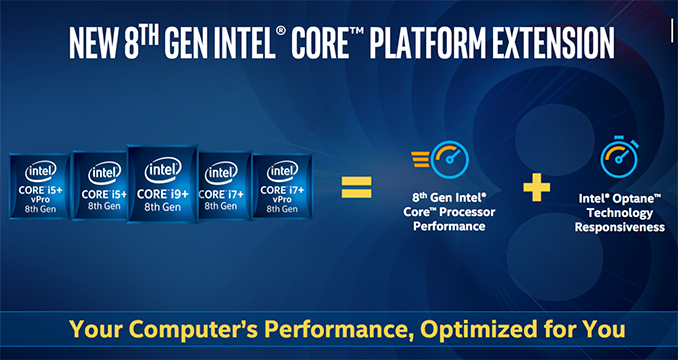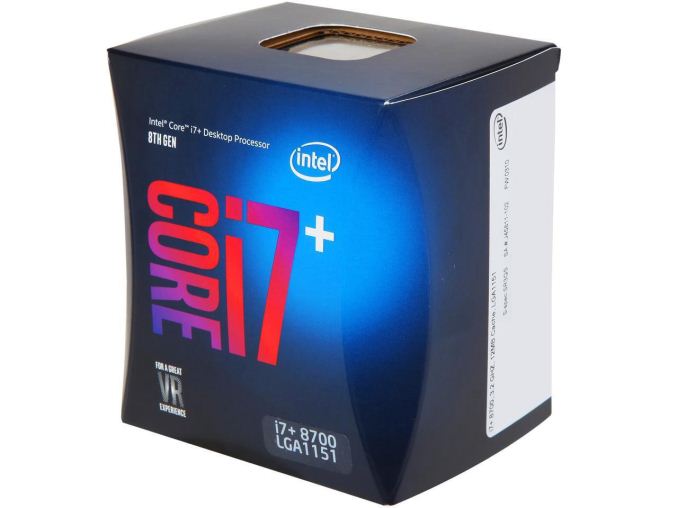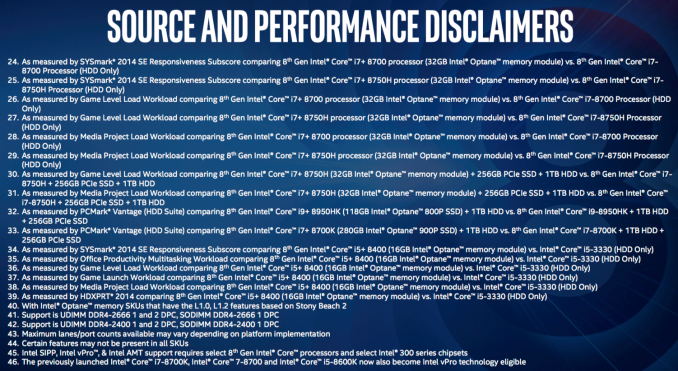Intel’s Core i5+, Core i7+ CPUs with Bundled Optane Memory Hit Retail
by Anton Shilov on April 12, 2018 5:30 PM EST
Earlier this month Intel introduced its Core i+ processor brand for desktops and laptops. The brand-within-a-brand setup sees Intel's 8th gen Core i5, i7, and i9 CPUs bundled with its Optane caching SSDs (aka Optane Memory) and sold as the i5+, i7+, and i9+ respectively. The chip giant aims such CPUs at customers who would like to improve performance of their storage subsystems yet won't be investing in full-fledged SSDs. And, after showing up in OEM systems with last week's launch, the Core i+ processors are now also to retail buyers.
Overall, Intel is rolling out the Core i+ in retail, targeting DIY end-users in the U.S., Canada, and Japan. The lineup of Intel’s Core+ CPUs for desktops currently consists of three SKUs: the Core i7+8700, the Core i5+8500 and the Core i5+8400. The bundles include 16 GB Optane caching drives and are priced at $340, $240 and $215, respectively. For mobile computers, Intel is also offering Core i9+ processor bundles, but it remains to be seen whether the company also plans to expand the family of its Optane-bundled offerings for desktops.
| Intel Core i5+ and Core i7+ CPUs with Bundled Optane Memory for Desktops | |||||
| Price with 16 GB Optane | Price of CPU only | PN | |||
| Core i7+8700 | $340 | $302 | BO80684I78700 | ||
| Core i5+8500 | $240 | $205 | BO80684I58500 | ||
| Core i5+8400 | $215 | $179 | BO80684I58400 | ||
With its Optane Memory products, Intel is attempting to kill two birds with one stone. Firstly, the company is capitalizing on demand for high-performance/high-capacity storage subsystems that combine responsiveness of SSDs and capacities of HDDs. Secondly, the company is ramping up production of its 3D XPoint memory and gaining experience in its high-volume manufacturing (i.e., improving yields), something that it is going to need to address needs of datacenter and enterprise market segments going forward.
This increased focus on selling lower capacity Optane modules for caching comes as Intel has made some notable changes to their caching subsystem to improve its usefulness. The Optane software can now cache data from any HDD (not just the primary/boot one), opening up interesting usage scenarios with secondary HDDs for end-users who have already invested in a SSD for their boot drive.
Intel says that a hybrid storage subsystem accelerated by a 32 GB Optane caching SSD is 1.7 – 3.9 times faster when compared to a non-accelerated HDD-based subsystem (see the slides below for details). The performance boost only occurs in situations when cached data is used, so a caching SSD is not a replacement for a regular SSD. However, it is considerably cheaper and since it does improve user experience, it makes the Core i+ bundles particularly useful for PC makers.
Last year Intel teamed up with select makers of motherboards to bundle its Optane caching SSDs with their platforms. This year the company is shifting its strategy and intends to sell such drives with its CPUs.
Related Reading:
- The Intel Optane Memory (SSD) Preview: 32GB of Kaby Lake Caching
- The Intel Optane SSD 800p (58GB & 118GB) Review: Almost The Right Size
- The Intel Optane SSD 900p 480GB Review: Diving Deeper Into 3D XPoint
Sources: TechReport, Tom’s Hardware













42 Comments
View All Comments
YukaKun - Thursday, April 12, 2018 - link
I answer to myself: It's in the first link xDxidex2 - Friday, April 13, 2018 - link
Like seriously? 80 cents is a discount for you? You must be a troll or something.YukaKun - Friday, April 13, 2018 - link
I do like trolling from time to time, yes. In this case, I'm not though.The word "value" does not mean what you think it means.
Cheers!
p1esk - Thursday, April 12, 2018 - link
Does anyone still uses HDDs in 2018 for anything other than NAS?Ryan Smith - Thursday, April 12, 2018 - link
Games. At $0.30-$0.40/GB, SSDs are still very expensive for storing games.FwFred - Thursday, April 12, 2018 - link
I guess you don't have a large multi terabyte photo and video Lightroom catalogue.Flunk - Friday, April 13, 2018 - link
A 16GB Optane buffer isn't going to help much with that either.Phyzzi - Friday, April 13, 2018 - link
If you do serious photo or video editing, it absolutely could help with that, even if it was just keeping the editor in cach so you don't have to wait for a hdd lookup each time you use a program featurewumpus - Monday, April 16, 2018 - link
I think you are wildly overestimating how much memory a photo can take up (gigapixels? really?). Video is of course another story, and you could always user more memory, but is 16G really enough to make a difference (I'm guessing yes, but you still want to pop for 32G or more).Considering this is a CPU bundle (and thus starting a build), for video editing I would certainly start with Ryzen, and try to move as much to SSD as possible (and especially find out if the 470 could make my life easier and preferably using a PCIe SSD as cache.
MattTheTechLV - Friday, April 13, 2018 - link
You would be surprised how many first time clients I get, that don't have even have an SSD for a boot drive. It's almost always the first thing I do with a new client, is get them purchase enough 850/950 Evos for every Workstation in their business, and allow me to migrate the systems over, and they ALWAYS have the same surprised reaction, they will never go back to traditional spinning rust.It's easy for us in the enthusiast market to wonder how not everybody has converted by now, but trust me, there is a whole world of small to midsize businesses out there, that haven't even heard of SSDs, and have no CTO or IT department to advise them, and then to think, all their employees that work on these slow systems who go home and probably have systems just as slow because they also don't know about SSDs, trust me, they are out there.